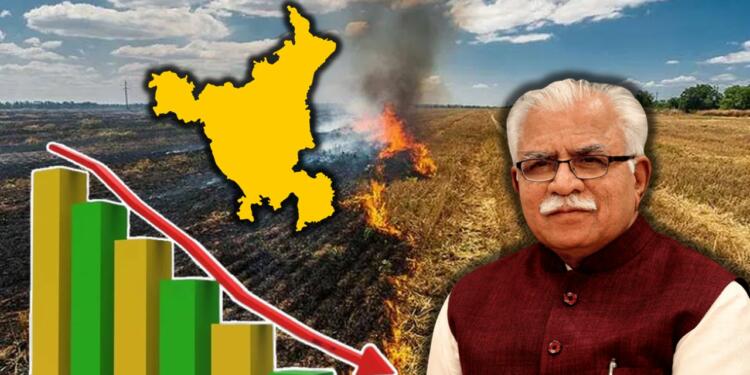Air pollution in the National Capital Region (NCR) during the latter part of October has perennially posed a challenge for both the incumbent administration and the neighboring states. However, in a notable departure from the norm, Haryana is committed to reducing the menace of stubble burning.
The Haryana government recently made an encouraging announcement, highlighting a significant reduction in paddy stubble-burning incidents compared to the previous year. Let’s delve into the details.
Haryana: Decline in Stubble Burning Cases
As per the available data, from September 15 to October 22 this year, Haryana reported a total of 714 cases of stubble burning. This number is considerably lower than the 893 cases reported during the same period in 2022. A significant contrast can be observed when looking at the figures from 2021, where a much higher 1,508 incidents occurred during this period.
Also read: Stubble burning: The contrasting stories of Haryana, Delhi, and Punjab
Regional Variations
The data reveals that the highest number of stubble-burning incidents were reported in Fatehabad, with 106 cases. Ambala and Jind followed closely with 93 cases each. Notably, there have been no reported crop residue burning incidents in NCR districts like Gurgaon, Charkhi Dadri, Mahendragarh, Mewat, and Rewari. Faridabad witnessed only two such incidents, while Sonipat reported 46 cases this year.
Air Quality in Haryana
As of 4 pm on Monday, the air quality in several parts of Haryana was in the “poor” category, including Faridabad, Manesar (Gurgaon), Bahadurgarh (Jhajjar), Ballabgarh (Faridabad), Jind, Kaithal, Karnal, and Kurukshetra. However, in other regions of Haryana, the air quality index (AQI) was either “moderate” or “satisfactory.” Impressively, there were several districts where the impact on AQI was almost negligible.
Haryana’s Commitment to Stubble Management
In a recent press briefing, the Haryana administration, led by Chief Minister Manohar Lal Khattar, reiterated their commitment to addressing the issue of stubble burning. The CM stated, “The state government is actively pursuing concrete measures for stubble management, which are yielding positive results.” He emphasized the collaborative efforts with farmers that have led to a substantial decrease in such incidents.
Also read: Exclusive Conversation with Supreme Court lawyer Shashank Shekhar Jha over Stubble burning
The government has been proactive in conducting awareness campaigns to discourage stubble burning. Additionally, it has provided financial incentives to farmers, offering Rs 1,000 per acre for implementing proper stubble management practices and refraining from burning crop residue.
The declining trend in stubble-burning cases in Haryana not only reflects the government’s determination to combat air pollution but also the cooperation and responsibility of the farming community. Together, these efforts are not only preserving the environment but also contributing to better air quality and health for the residents of Haryana and neighboring regions.
It’s heartening to witness a positive shift in the approach to managing stubble burning and reducing air pollution. As the Haryana government continues its efforts and collaboration with farmers, the hope is that this trend will further strengthen, leading to cleaner and healthier air for all. It’s a testament to the collective responsibility we all share in safeguarding our environment and public health.
Support TFI:
Support us to strengthen the ‘Right’ ideology of cultural nationalism by purchasing the best quality garments from TFI-STORE.COM.





























